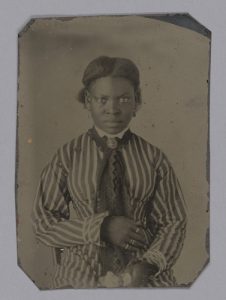Bianca Williams
Professor Kappes
English 302
5, March 2018

Black Excellence
Captured above is a 2 ¾ x 2 in. tintype portrait of a young unidentified African American woman, in the late 1860’s. Also known as melainotype, is a photograph made by producing an exact positive on a fine sheet of metal covered with dark lacquer or enamel. The young woman illuminates the notion of black excellence, which Aphra Behn romanticizes in her 17th century novella Oroonoko: or Royal Slave. Black excellence is the beauty we possess and display through fashion, status, attitude, and morals. The unidentified woman’s sharp stare and wardrobe are strong like Behn’s description of Oroonoko and she supports the text with her appearance. Her ring-covered fingers evoke a royal sentiment and cannot go unnoticed. We can suggest that both artists chose to present their subjects’ greatest assets. The unidentified woman and Oroonoko compliment one another in terms of appearance as they both display strapping physical features and are both uniquely strong,
In the tintype, an unidentified woman is captured in a sitting position, facing forward. She is seen wearing a striped dress; her hair is parted down the center and pulled back behind her ears. In this portrait she is seen with her right arm crossed over her abdomen. Her right hand is adorned with rings and she is holding what appears to be a white handkerchief or napkin in her left hand rested on her lap. She is not smiling; her eyes are wide and focused on the camera. Around her neck is a dark ruffled scarf held by a brooch. Her expression is a fortress, the arch in her eyebrows, fiery eyes and ebony skin tell a story. This still image tells the audience that this woman is free. Her garments and jewelry are just a small indication of that. Her piercing eyes are the center of this portrait and her position shows no sign of insecurity, much like Behn’s protagonist Oroonoko. Behn introduces Prince Oroonoko using the following description, “He was adorned with native beauty, so transcending…he struck an awe and reverence even into those that knew not his quality; as he did into me, who beheld him with surprise and wonder…” (12). Behn’s narrative supports this idea of black excellence because she claims to have witnessed it; African royalty and she is “struck” by prince Oroonoko’s physical attributes. Beauty is heavily represented in both mine and Behn’s description of our subjects, and is just one element that encompasses the idea of Black excellence.
Upon discovery of the unidentified woman, like Behn, I was struck by her physical characteristics. Her poise and compelling stare stood out, as did Oroonoko to Behn. She was so intrigued by his physical makeup that her curiosity grew, as she states plainly in the text, “This great and just character of Oroonoko gave me an extreme curiosity to see him.” (13) The tintype possesses the same affect and one could not help but wonder what this woman’s thoughts were and how she might have lived her day to day life. Although this young woman’s story remains unknown, the time period in which her portrait was taken has a very dark one, and like Oroonoko she may have experienced the harsh realities of that time.
Furthermore, Behn’s oriental lense of Oroonoko is what divides these individuals. The portrait is of an actual person, dressed in real clothing and jewels, Oroonoko’s features and behaviros are exocitized by orientialism, falsifying this idea of black excellence truly existing. He is depicted in way that would have fancied the european reader, “He had nothing of Barbarity in his Nature, but in all points address’d himself, as if his Education had been in some European Court.” (13) Behn’s elaborate perspective denies the thought of excellence within black people without some type of european influence. Photographs like the unidentified black woman support the existence of beauty and power in black people.
Work Cited
Behn, Aphra, and Philip Henderson. Oroonoko, or, The Royal Slave: a True History. The Temple-Cloyfters,
“Tintype of a Young Woman in a Striped Dress.” National Museum of African American History and Culture, nmaahc.si.edu/object/nmaahc_2014.37.22.5?destination=explore/collection/search?page=1&edan_q=*:*&edan_fq[0]=topic:”Photography”&edan_fq[1]=date:”1860s”&edan_local=1.

